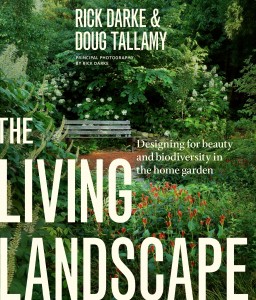Reviews by Edie Parnum
Want to become a better steward of nature on your land? These two books will inspire and guide you. Doug Tallamy’s popular book, Bringing Nature Home: How You Can Sustain Wildlife with Native Plants, taught us to love native plants for the leaf-eating insects they host. Tallamy has now teamed up with landscape architect Rick Darke on a new book that helps us create aesthetically pleasing landscapes for our native creatures. Heather Holm’s book teaches us to garden for insect pollinators and appreciate the ecosystem roles they play. We can help the environment by what we plant in our yards. These books tell us how.
The Living Landscape: Designing for Beauty and Diversity in the Home Garden by Rick Darke and Doug Tallamy
- This book is beautiful—so beautiful you can display it on your coffee table. The photographs show landscapes, combinations of native plants, and the creatures who live there. These images inspire us to create esthetically pleasing wildlife habitats that are alive with biodiversity.
- The pictures and text explain how to design for beauty using native plants. Instead of planting them haphazardly, we learn to position and combine natives to create an alluring garden.
- The authors teach us to imitate natural habitats by planting in layers: ground, herbaceous, shrub, understory, and canopy.
- Instead of photos of individual plants, the book illustrates native plants as part of the landscape and showcases the birds, butterflies, and other creatures living there.
- A practical book, low maintenance gardening is emphasized. It recommends pleasing combinations of plants that don’t out-compete each other or require excessive weeding. We learn to anticipate changes in our landscapes over time, especially when planting trees and shrubs.
- The plant lists, organized by geographical area, are superbly designed to help us make plant selections. Symbols concisely indicate the ecological functions for each plant, e.g., nest sites, pollen, nectar, seasonal foods for birds, and food for caterpillars. Other symbols represent landscape functions such as seasonal flowering, fall foliage, fragrance, or groundcover.
- The plant lists also specify the ecological benefits to humans. Not normally emphasized, these paybacks include carbon sequestration, shading and cooling, watershed protection, moderation of extreme weather, and air filtration.
Pollinators of Native Plants: Attract, Preserve and Identify Pollinators and Beneficial Insects with Native Plants by Heather Holm
- Like flowers? You surely love pollinators, too! You can’t have one without the other. Plus, flowers and their pollinators create seeds, fruits, and nuts—actually a third of the food we eat. Of course, animals of all kinds require these food products, too.
- Butterflies, the most charismatic of the insects attracted to flowers, already have fans. Now, with this book, we also learn to value pollinating bees, wasps, moths, flies, and beetles—really!
- The bulk of the book describes the best pollinator-attracting plants and the interactions between their flowers and the pollinating insects.
- Insect pollinators are fascinating. We can easily observe and identify them by watching the book’s featured flowers and examining their insect visitors. The excellent photographs in the book help us identify these bees, flies, and other insects. Then we can observe each insect’s strategy as it probes for nectar and/or collects pollen. We may see insect interactions like predation, copulation, and parasitization, too.
- Using this book we home gardeners can select pollinator-attracting plants for the various growing conditions on our properties.
- By planting Holm’s recommended pollinator plants and observing pollination in action, we will revel in the flourishing ecosystem we’ve created.
I highly recommend both of these books. They will help you beautify your garden and increase its ecological value for all the creatures who inhabit it.



